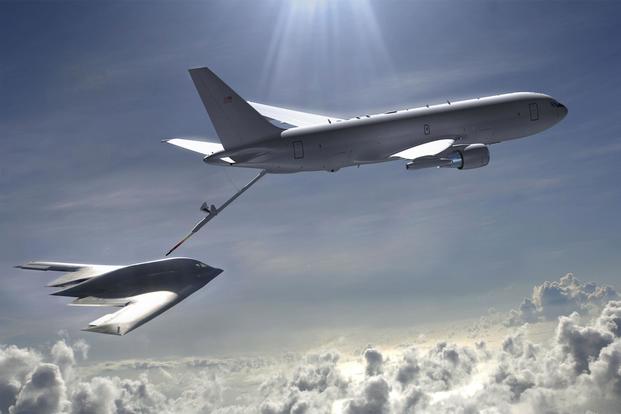The Air Force is drawing up plans for its next refueling tanker to have autonomous or semi-autonomous capabilities, thanks in part to efforts to fix the KC-46 Pegasus, according to the service's acquisition czar.
Dr. Will Roper, assistant secretary of the Air Force for acquisition, technology and logistics, said a required redesign of the KC 46's Remote Vision System (RVS), which permits the in-flight operator to view the refueling system below the tanker, is bringing the tanker to the brink of autonomous refueling with its latest suite of sensors and in-flight tracking.
Read Next: Camp Lejeune Marines Warned to Stop Running in the Dark After 4 Coyote Attacks
"The KC-46 is going to take us all the way up to the doorstep of semi-autonomous and autonomous tanking," Roper said Wednesday during a phone call with reporters. "And the Air Force has committed to put in those algorithms because, when you build a properly designed RVS, you've done everything needed to do autonomous tanking. The only thing you're missing are the algorithms to actually do it."
The Air Force reached an agreement in April with Boeing Co., the KC-46's maker, on the final RVS redesign, known as RVS 2.0. Currently, a glitch in the system doesn't allow an airman to look at a clear, aligned visual of the boom connecting to another aircraft. The first tankers were delivered to the service in 2019 despite that problem.
While the Air Force has opened the door to the option of autonomous tanking, there's no requirement to do so, Roper said, adding that he posed the idea to Gen. Jacqueline Van Ovost, head of Air Mobility Command, to research follow-on capabilities for the KC-46A, as well as future tanker fleets.
"Now's a great time to start studying that and to do it in conjunction with what comes next. So what comes after KC 46?" he said.
Echoing other top brass, Roper said the Air Force is prioritizing survivability for the future fleet. Tankers are traditionally seen as the backbone for fighters and bombers operating over hostile airspace, providing fuel to keep combat aircraft flying for hours on end.
"We're definitely going to be thinking about autonomy as a way to change the risk calculus," he said, "so looking at something that is stealthy and more survivable is a different way we could go, [or] looking at something that's defendable."
The concept of a "stealthy tanker" has come up before.
In 2016, then-AMC commander Gen. Carlton Everhart II mentioned the prospect of minimizing a tanker's radar cross-section, or detectability. He explained that, while it may be hard for adversaries to spot a fifth-generation stealth fighter, its cover is blown if it's refueling from an easily identifiable refueler.
Enemies "don't have to look for the fifth-gen. Look for the first-gen [because if] you take out the tanker, fighters don't have gas, [and the enemy] wins," he said in 2017.
Next-generation technologies should be considered regardless of the path the Air Force takes for a future tanker, whether it's an upgraded KC-46 or an altogether new design, Everhart added.
"Do we bridge -- that's the reason why we may look at a KC-46 Bravo -- what are the survivable capabilities for the aircraft, what are the requirements, and what do we project the requirements of the world to be?" he said.
-- Oriana Pawlyk can be reached at oriana.pawlyk@military.com. Follow her on Twitter at @Oriana0214.
Related: Air Force Cargo Planes Could Get New Job in the Fight












